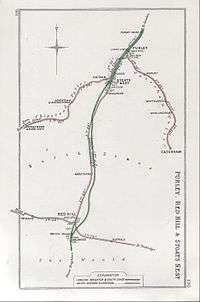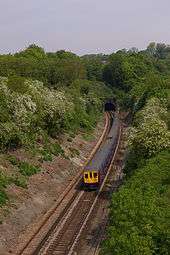Merstham tunnels
Coordinates: 51°16′26″N 0°09′07″W / 51.274°N 0.152°W

The Merstham and Quarry tunnels are two railway tunnels on the Brighton main line between Merstham and Coulsdon (formerly Stoats Nest) in Surrey, Great Britain. They were built nearly sixty years apart.
Merstham Tunnel

The original tunnel through the North Downs was constructed under the supervision of the engineer John Urpeth Rastrick for the London and Brighton Railway (L&BR) between 1839 and its opening on 12 July 1841. It was cut through chalk, using twelve vertical shafts, up which the spoil was raised to the surface in skips by means of horse-drawn winches.[1] The tunnel was originally intended to be 2013 yards (1841 metres, or 1.14 miles) in length, but during construction it was realigned and became 1830 yards (1673 metres or 1.04 miles) long.[2] The new tunnel was finished with brick portals, whitewashed and lit by gas lamps supplied from a small gas works south of Merstham station.[3]
The two-mile railway cutting to the north of the tunnel is one of the largest in Europe and is 100 feet (30 metres) deep at the northern entrance to the tunnel.[4] Its construction involved the removal of more than a million cubic yards (800,000 cubic metres) of chalk.[5]
Although the tunnel was built by the L&BR, it was on a section of line between Croydon and Redhill that was to be shared with the South Eastern Railway (SER), when they commenced services on their route to Dover in 1842. On 16 July 1844 the SER refunded half of the construction cost of the joint line and took ownership of the section between Purley and Redhill, including the Merstham Tunnel.
This tunnel was the site of the unsolved murder of Mary Sophia Money in 1905. Marks were discovered on the tunnel wall showing Miss Money had been thrown to her death from a moving train.
Quarry Tunnel

The sharing of the main line caused a great deal of friction between the SER and the London Brighton and South Coast Railway (LB&SCR), the successor of the L&BR, throughout the 19th century. Eventually the LB&SCR gained Parliamentary approval to build its own independent line between Coulsdon North and Earlswood, which bypassed the SER stations of Coulsdon South, Merstham and Redhill. This involved the construction of a second tunnel to the east of the original, and 25 feet (7.6 metres) above the level of the original. Since both routes form part of the Brighton Main Line, in order to differentiate them the former was called the "Redhill Line", whilst the new line became known as the "Quarry Line".
Quarry Tunnel is 2113 yards (1932 metres, or about 1.2 miles or 1 mile 1.6 chains) in length and was built between 1896 and its opening on 8 November 1899. The contractors were Messrs Firbank, and the estimated cost was £85,000.[6] The new tunnel was approached by a 100 ft deep cutting on the north side.
Electrification
The lines through both tunnels were electrified in 1932 by the Southern Railway.
References
- ↑ Whishaw, Francis (1842). The Railways of Great Britain and Ireland. Weale. p.273.
- ↑ Turner, John Howard (1978). The London Brighton and South Coast Railway 2 Establishment and Growth. Batsford. ISBN 0-7134-1198-8. p. xii.
- ↑ Turner (1977) p.141.
- ↑ Turner, John Howard (1977). The London Brighton and South Coast Railway 1 Origins and Formation. Batsford. ISBN 0-7134-0275-X. p.118.
- ↑ Whishaw p.272.
- ↑ Turner, John Howard (1979). The London Brighton and South Coast Railway 3 Completion and Maturity. Batsford. ISBN 0713413891. p.117-122.